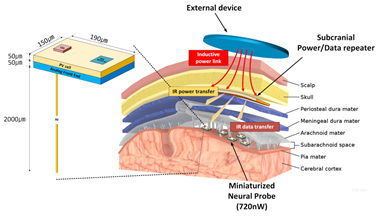Spiking Neural Network for Motor Function Decoding Based on Neural Dust
From iis-projects
Contents
Description
A brain-machine interface (BMI) acquires brain activity and translates the information into actions to control software and hardware such as computers and prostheses. As a potential treatment for many neurological diseases, it has won great attention in academia and industry.
Researchers have developed mm-scale implantable neural probe [1][2] aiming to restore motor function while reducing the damage caused by the implantation. Such systems pose stringent constraints on the power consumption, area, and latency.
Spiking neural network (SNN), an emerging brain-inspired algorithm, takes advantage of asynchronous information and computation to achieve low latency and low power consumption. Unlike images or sounds acquired by conventional sensors, the neural signals are naturally asynchronous and encode information in timing and firing rate, which is perfectly compatible with SNN’s requirement for input data. This makes SNN a good candidate for neural decoding, and the nature of neural signals may release more potential of SNN.
In particular, reservoir-based Liquid State Machine (LSM) [5] is a recurrent computational model which is a more adequate emulation of the biological cortical networks compared to layer-based SNNs. It maps the input spike trains to the output spike trains by means of the so-called Liquid or reservoir, which consists of a recurrent neural network formed by many computational nodes. Kasabov [6] proposed a reservoir-based SNN, named NeuCube, to learn and understand the spatio-temporal features of the brain activities and has been demonstrated to be competitive to layer-based approaches. A very recent work [7] used NeuCube to perform the regression problem of Grasp-and-Lift dataset achieving very promising results.
In this project, the student will
1. Study prior art, including and not limited to LSM, SNN
2. Get familiar with the dataset, the system, and the deep learning framework
3. Explore and develop SNN to offline decode finger movement A more detailed project description will be provided tailored to the type of the project (master or semester).
Status: Available
- Looking for master or semester thesis students
- Supervisor: Jiawei Liao, Xiaying Wang, Alfio Di Mauro
Prerequisites
- Machine Learning
- Deep Learning
- Python
- VLSI is a plus
Character
- 20% Literature review
- 20% Theory
- 60% Programming
Professor
Prof. Taekwang Jang <tjang@ethz.ch>
Reference
[1] J. Lim et al., “26.9 A 0.19×0.17mm 2 Wireless Neural Recording IC for Motor Prediction with Near-Infrared-Based Power and Data Telemetry,” in 2020 IEEE International Solid- State Circuits Conference - (ISSCC), San Francisco, CA, USA, Feb. 2020, pp. 416–418. doi: 10.1109/ISSCC19947.2020.9063005.
[2] E. Moon et al., “Bridging the ‘Last Millimeter’ Gap of Brain-Machine Interfaces via Near-Infrared Wireless Power Transfer and Data Communications,” ACS Photonics, vol. 8, no. 5, pp. 1430–1438, May 2021, doi: 10.1021/acsphotonics.1c00160.
[3] S. R. Nason et al., “A low-power band of neuronal spiking activity dominated by local single units improves the performance of brain–machine interfaces,” Nat Biomed Eng, vol. 4, no. 10, pp. 973–983, Oct. 2020, doi: 10.1038/s41551-020-0591-0.
[4] A. K. Vaskov et al., “Cortical Decoding of Individual Finger Group Motions Using ReFIT Kalman Filter,” Front. Neurosci., vol. 12, 2018, doi: 10.3389/fnins.2018.00751.
[5] W. Maass, et al., “Real-time computing without stable states: A new framework for neural computation based on perturbations”. In Neural Computation 14, 2002, pp. 2531–2560.
[6] N. K. Kasabov, "NeuCube: A spiking neural network architecture for mapping, learning and understanding of spatio-temporal brain data." Neural Networks 52, 2014, pp. 62-76.
[7] Kumarasinghe, et al., D. Brain-inspired spiking neural networks for decoding and understanding muscle activity and kinematics from electroencephalography signals during hand movements. Sci Rep 11, 2486 (2021). https://doi.org/10.1038/s41598-021-81805-4
